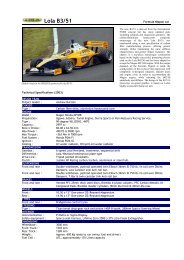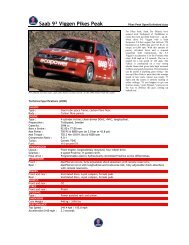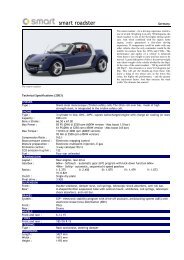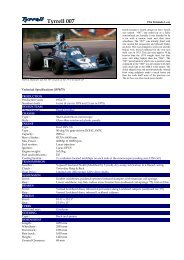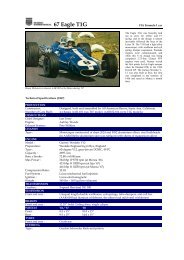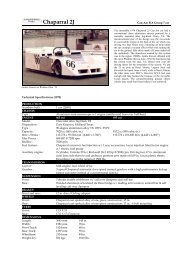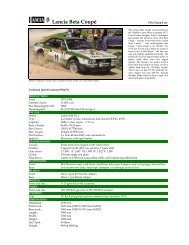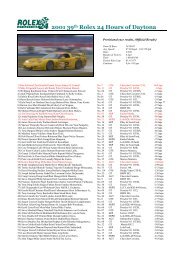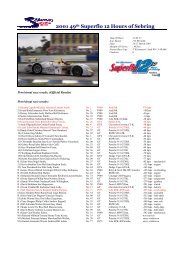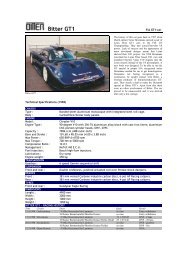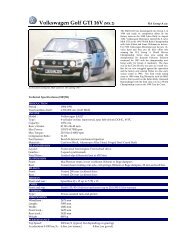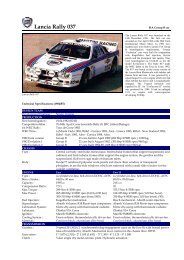84 Renault 5 Turbo - Motorsports Almanac
84 Renault 5 Turbo - Motorsports Almanac
84 Renault 5 Turbo - Motorsports Almanac
Create successful ePaper yourself
Turn your PDF publications into a flip-book with our unique Google optimized e-Paper software.
<strong>Renault</strong> 5 <strong>Turbo</strong> 'Tour de Corse' FIA Group B-car<br />
Jean Ragnotti on the 19<strong>84</strong> Rally of Portugal<br />
Technical Specifications (1983/<strong>84</strong>)<br />
The <strong>Renault</strong> 5 <strong>Turbo</strong> car was introduced<br />
to the general public at the 1978 Paris<br />
Motor Show. Visitors were immediately<br />
won over by its compact, dynamic look,<br />
strapping wings, and unusual interior<br />
treatment. But the <strong>Renault</strong> 5 <strong>Turbo</strong> was<br />
anything but a showroom car. When it<br />
went on sale in July 1980, the <strong>Renault</strong> 5<br />
<strong>Turbo</strong> was the first French car to be<br />
equipped with a turbocharger. Drawing<br />
on both competition and road car<br />
technology, it embodied everything the<br />
engineers had learned from motor sport.<br />
With an output of 160bhp from only<br />
1397cc, the <strong>Renault</strong> 5 <strong>Turbo</strong> produced<br />
some astonishing figures. It made its<br />
racing début in the Tour of Italy in 1979.<br />
Next came the 1980 Tour of Corsica,<br />
where the car, skilfully driven by Jean<br />
Ragnotti, would have been hard to beat<br />
but for a mechanical fault. Its first victory<br />
came at the Monte Carlo rally in 1981 -<br />
only its fourth race.<br />
HOMOLOGATION<br />
Début : 1978 Paris Salon<br />
FIA race début : 1980 Tour de Corse<br />
First win : 1981 Monte Carlo Rally<br />
Production start : May 20, 1980, at the Alpine plant in Dieppe, France<br />
Production period : 1980-1982 (<strong>Renault</strong> 5 <strong>Turbo</strong>)<br />
1983-1986 (<strong>Renault</strong> 5 <strong>Turbo</strong> 2)<br />
Special versions : 1982 ’Cevennes’ with 200PS<br />
1983 ’Tour de Corse’ with 240PS<br />
1985 ’Maxi <strong>Turbo</strong>’ with 350PS<br />
CHASSIS / BODY<br />
Type : <strong>Renault</strong> 5 sheet steel monocoque with an aluminium roof, aluminium doors and<br />
rear hatch.<br />
Body : Front and rear wings, front compartment cover, front and rear bumpers, rear wheel<br />
arch extensions and sill panels in GFP Polyester. Polyurethane foam roof gutter<br />
surrounds (rigid) and spoiler mounted to rear hatch upper beam.<br />
ENGINE<br />
Model : <strong>Renault</strong> <strong>84</strong>0-30 turbo<br />
Type : 4-cylinder, in-line, OHV side-mounted chain-driven camshaft, 2VPC, 5 main<br />
crankshaft bearings, hemispherical combustion chambers.<br />
Preparation : <strong>Renault</strong> Sport<br />
Capacity : 1397cc<br />
Bore x Stroke : 76.00 x 77. 00 mm<br />
Max Power : 300 PS @ 7000 rpm<br />
Max Torque : 329 Nm @ 5000 rpm<br />
Compression ratio : 7:1<br />
Ignition : Marelli electronic ignition.<br />
Fuel System : Bosch K-Jetronic mechanical.<br />
<strong>Turbo</strong> : Garrett T3, air/coolant intercooler.<br />
Boost control : Airflow control valve installed upstream of compressor, boost pressure control<br />
provided by double-function capsule taking account of information upstream and<br />
downstream of the compressor, and operating via a "wastegate" blow-off valve.<br />
Max boost : 0.86 bar
Cooling System : Pressurised cooling system with aluminium radiator.<br />
Materials : Cast iron block, light alloy head.<br />
TRANSMISSION<br />
Layout : Rear wheel drive, mid-engine installed ahead of the rear axle. Tripod CVJs, ø 82<br />
mm driveshafts.<br />
Gearbox : 5-speed <strong>Renault</strong> 369 (derived from <strong>Renault</strong> 30 TX), all synchromesh, manual shift,<br />
aluminium alloy casing, with cooling via radiator and electric pump.<br />
Ratio : I : 3,364: 1 (37/11)<br />
II : 2,059: 1 (35/17)<br />
III : 1,381: 1 (29/21)<br />
IV : 1,057: 1 (37/35)<br />
V : 0,868: 1 (33/38)<br />
R : 3,182: 1 (35/11)<br />
Final drive : Ratio: 3,889: 1 (35/9) 9 x 35 8 x 35, 9 x 31<br />
Clutch : MFZ 190 single dry-plate<br />
SUSPENSION<br />
Front : Double wheel-locating wishbones - load supporting lower wishbone, longitudinal<br />
torsion bars. Shock-dampers, 21mm anti-roll bar.<br />
Rear : Double wheel-locating wishbones, coil-over-dampers , 23mm anti-roll bar<br />
BRAKES<br />
Front and rear : 260 mm vented discs, ø 54 mm DBA series IV single-pot calipers<br />
WHEELS<br />
Front : 135 x 340 mm (TRX type)<br />
Rear : 195 x 365 mm (TRX type)<br />
TYRES<br />
Front : 190/55HR340 Michelin TRX<br />
Rear : 220/55VR365 Michelin TRX<br />
STEERING<br />
Type : Rack-and-pinion, 330 mm steering wheel, 3.2 turns end-to-end.<br />
ELECTRICAL SYSTEM<br />
Battery : 12V 250/50 Ah.<br />
Alternator output: 50 A. Integral regulator.<br />
DIMENSIONS<br />
Length : 3.66m<br />
Width : 1.74m<br />
Height : 1.32<br />
Turning circle, kerbs : 10.40 m<br />
Turning circle, walls : 10.90 m<br />
Kerb weight : 930kg<br />
Fuel tank : 93 litres<br />
PERFORMANCE<br />
Top Speed: 170-250kph depending on gearing<br />
Acceleration: 0-400m : 15.0sec<br />
RENAULT 5 TURBO HISTORY<br />
In 1972 <strong>Renault</strong> adopted the turbocharged engine in motor sport, an invention patented 70 years earlier by its<br />
founder. After wins in the Le Mans 24 Hours, the Monte-Carlo Rally and numerous Formula 1 Grands Prix, the<br />
turbo was adapted for production models. On December 17, 1902 the French patents office registered an<br />
application for a patent lodged by Louis <strong>Renault</strong>. The invention in question was "intended to increase the<br />
intake pressure of gas into cylinders of internal combustion engines [to] increase [...] the quantity of gas<br />
admitted into the cylinder on each aspiration. This quantity of gas being greater, compression will be higher,<br />
the effect of combustion greater and there will therefore be an increase in engine power." To obtain this result,<br />
Louis <strong>Renault</strong> installed "a fan or a small compressor on the tube carrying the combustible gases to the engine",<br />
the intake manifold of which was linked to the carburettor. The principle of supercharging by<br />
turbocompression was born. It was used in aviation and on <strong>Renault</strong> railway diesels until the 1960s, before<br />
coming back again ten years later, this time in the car. In Formula 3, <strong>Renault</strong> Alpines fitted with the 1600 cc<br />
<strong>Renault</strong> 16 engine were racing against higher-capacity engines. The idea of turbocompression emerged as the<br />
only way of increasing power without increasing engine capacity: the compressor could be driven by energy<br />
from the exhaust gas as opposed to engine-generated mechanical energy. Difficult beginnings Although the<br />
principle was simple enough, installing a turbocharger on a petrol engine required high-performance materials<br />
that could withstand pressure and delicate adjustments to be performed that the F3 engineers had neither the<br />
time nor the means to carry out. A talented engine mechanic by the name of Bernard Dudot (now technical<br />
director of <strong>Renault</strong> Sport) "souped up" an Alpine Berlinette with a supercharger which increased its power by<br />
nearly 30% (giving it very nearly 200 bhp!), but still qualified it for the starting grid of the 1972 Civennes<br />
criterium. It pulled off a completely unexpected victory, due as much to the talent of its driver, Jean-Luc
Thirier, as to its engine. As there was a 2 to 3 second delay between accelerator movement and response (with<br />
the same phenomenon on slowing down), acceleration and braking had to practically be reversed! Jean<br />
Terramorsi, then head of <strong>Renault</strong> Gordini, nonetheless believed that <strong>Renault</strong> had the technology in its grasp<br />
that would one day allow them to beat Porsche in the Le Mans 24-hour race. He convinced new CEO Bernard<br />
Vernier-Palliez of the feasibility of adapting a turbocharger for the V6 2.0 L racing engine. First time out, in<br />
March 1975, the Alpine A 441 driven by Jean-Pierre Jabouille outclassed both Porsche and Alfa Romeo at<br />
Mugello. A master-stroke, indeed, but still an experimental one. In 1977, the three Alpine <strong>Renault</strong>s in the Le<br />
Mans race fell victim to "the Hunaudieres syndrome", a burnt-out piston at the end of the famous straight.<br />
Engineers worked all year long at improving the endurance of the engine, testing it on American circuits with<br />
their long straights, which are almost as long as the Hunaudieres. They then moved it to a new test bench,<br />
delivered only a few months before the race, where they could simulate the Le Mans track as many times as<br />
they wished. 1978, a golden year Finally, on June 12, 1978 Jaussaud and Pironi overtook the two Porsche 936s<br />
to cross the finishing line, with an average speed of 201 kph. This win resolved <strong>Renault</strong> to pursue its Formula 1<br />
racing venture, begun the year before. Jean Terramorsi, however, cherished a different dream: that of adapting<br />
a turbocharger on a <strong>Renault</strong> 5 to compete in international rallies. But it was after his death, the year of the Le<br />
Mans victory, that the first prototype rolled out, with a 1,397 cc engine, a derivative of the unbreakable "Clion<br />
fonte". The same year, the first production <strong>Renault</strong> 18 <strong>Turbo</strong>s rolled off the lines. In 1981, overthe snowy<br />
heights of the Monte-Carlo rally, Jean Ragnotti made his mark in the <strong>Renault</strong> 5 <strong>Turbo</strong>. Four years later, it was<br />
the <strong>Renault</strong> 5 Maxi <strong>Turbo</strong>, benefiting from numerous innovations developed for Formula One, that won the<br />
French superproduction championship.<br />
RENAULT 5 TURBO - DESCRIPTION<br />
A wizard at rallies and a virtuoso on the racetrack, the <strong>Renault</strong> 5 <strong>Turbo</strong> is still an exceptional vehicle more than<br />
20 years after it was first produced. This thoroughbred had a thrusting, athletic look and was the first French<br />
car running on petrol to be fitted with a turbocharger. Glowing references that gave it direct access to the<br />
world of legendary cars. Maxi 5 <strong>Turbo</strong> An idea... and the will to make it work : As well as the convincing<br />
result of a technical demonstration, the <strong>Renault</strong> 5 <strong>Turbo</strong> was the culmination of a tale of extraordinary human<br />
endeavour. It was the brainchild of Jean Terramorsi, deputy director of the Product Planning Department who<br />
was in charge of small-scale production models, and his assistant Henry Lherm in 1976. They wanted to bring<br />
out a more powerful version of the best-selling <strong>Renault</strong> 5, which was then being produced at a rate of 2,400<br />
units per day, by fitting it with a turbocharger. Dubbed project number 822, the assignment would take four<br />
years to complete. Senior management gave the go-ahead because they believed it was important to come up<br />
with a successor to the <strong>Renault</strong> 8 Gordini and the Alpine Berlinette. The specifications : Jean Terramorsi died<br />
later in 1976 but his project lived on. The <strong>Renault</strong> Sport engineers got down to the task of designing the turbo<br />
engine, while styling was entrusted to the <strong>Renault</strong> Alpine company. The specifications were extremely<br />
detailed. They stated that the <strong>Renault</strong> 5 <strong>Turbo</strong> must be "a powerful, easy-to-drive vehicle with excellent<br />
roadholding, capable of shining on the racing circuits with only a small number of alterations". Other<br />
requirements included a 1.4-litre turbocharged engine, five-speed gearbox, maximum weight of 950kg,<br />
substantial comfort, good soundproofing and an overall appearance similar to that of the <strong>Renault</strong> 5. It was also<br />
quite a challenge to design a racing car on which a roadgoing model aimed at the general public would be<br />
based. That was another first. March 9, 1978 : late at night, as about 20 people gathered at a racetrack near<br />
Arques-la-Bataille, not far from Dieppe, a growl was heard. It came from the first prototype of the <strong>Renault</strong> 5<br />
<strong>Turbo</strong>, which immediately got off to a good start. Among the group were Gerard Larrousse, head of <strong>Renault</strong><br />
Sport, and Michel Tétu, an excellent all-round engineer who provided the technical input for the <strong>Renault</strong> 5<br />
<strong>Turbo</strong>. Further tests and adjustments were carried out. Aluminium put in an appearance on the doors and<br />
tailgate, and the Garrett company was selected to supply the turbo. Unveiling in Paris and on to victory : The<br />
new car was introduced to the general public at the 1978 Paris Motor Show. Visitors were immediately won<br />
over by its compact, dynamic look, strapping wings, and unusual interior treatment. But the <strong>Renault</strong> 5 <strong>Turbo</strong><br />
was anything but a showroom car. It was happier eating up the miles on the open road or getting to grips with<br />
the rally circuits. It made its racing début in the Tour of Italy in 1979. Next came the 1980 Tour of Corsica,<br />
where the car, skilfully driven by Jean Ragnotti, would have been hard to beat but for a mechanical fault. Its<br />
first victory came at the Monte Carlo rally in 1981 - only its fourth race. Monaco, May 1982: <strong>Renault</strong> 5 <strong>Turbo</strong><br />
Cup An astonishing winning machine : The following season saw Ragnotti's car win the Tour of Corsica.<br />
Even so, <strong>Renault</strong>'s absolute priority was its commitment to Formule 1, which meant the R5 <strong>Turbo</strong> did not take<br />
part in the world championship. Nonetheless, a lightweight, independent body was set up to continue the<br />
adventure and run national championships for the various subsidiaries. A Racing Customers Department was<br />
opened to sell more than 350 racing cars to professional or amateur drivers, offering a choice of five different<br />
models. Between 1981 and 1986 the R5 <strong>Turbo</strong> added to its list of international wins. The drivers who took it to<br />
victory were little known at the time but were soon to make names for themselves. They included Carlos Sainz,<br />
Didier Auriol, Bruno Saby, Francois Chatriot and Dany Snobeck. From racing to current production : The<br />
assembly line for the <strong>Renault</strong> 5 <strong>Turbo</strong>, which provided a link between racing cars and roadgoing models, went<br />
into production at the Alpine plant in Dieppe on May 20, 1980. A total of 802 units, available in red or blue,<br />
were made that year, 536 the next year and 352 the year after that. The European Cup : On April 5, 1981, the<br />
<strong>Renault</strong> 5 <strong>Turbo</strong> Cup was launched on the Hockenheim circuit in Germany. The first season covered 12 races<br />
on the leading European circuits, starting with Formula 1 Grands Prix and the Le Mans 24-hour race. All these
events helped to further establish the fame of the car that won hearts and raised dust all over Europe. They<br />
also confirmed that its founding fathers were right to have made a commitment to an exceptional human and<br />
technological adventure.<br />
PRODUCTION SUMMARY<br />
Numbers built : 1980 : 804 (<strong>Renault</strong> 5 <strong>Turbo</strong>)<br />
1981 : 571 (<strong>Renault</strong> 5 <strong>Turbo</strong>)<br />
1982 : 445 (<strong>Renault</strong> 5 <strong>Turbo</strong>)<br />
1983 : 1345 (<strong>Renault</strong> 5 <strong>Turbo</strong> 2)<br />
19<strong>84</strong> : 1497 (<strong>Renault</strong> 5 <strong>Turbo</strong> 2)<br />
1985 : 182 (<strong>Renault</strong> 5 <strong>Turbo</strong> 2)<br />
1986 : 143 (<strong>Renault</strong> 5 <strong>Turbo</strong> 2)<br />
Total : 4987 cars<br />
COMPETITION HISTORY – RENAULT 5 TURBO<br />
Year Driver Championship Other info<br />
1980 Jean Ragnotti French Rally Champion -<br />
1981 Jean Ragnotti Winner Monte Carlo Rally -<br />
Bruno Saby French Rally Champion -<br />
1982 Jean Ragnotti Winner Tour de Corse -<br />
Jean-Luc Thérier French Rally Champion -<br />
1983 Various Spanish and Greek National Champions Total 70 wins in 1983.<br />
19<strong>84</strong> Jean Ragnotti French Rally Champion -<br />
1985 Jean Ragnotti Winner Tour de Corse -<br />
IMAGE GALLERY<br />
Jean Ragnotti on the ’83 Tour de Corse driving a <strong>Renault</strong> 5 <strong>Turbo</strong> 2 ‘Tour de Corse’<br />
Lars-Erik Walfridsson on the ’82 Swedish Rally Dany Snobeck on the 1985 Monte Carlo Rally<br />
SOURCES<br />
http://www.renault.com/gb/passion/culte_p4.htm<br />
http://www.retdmag.renault.com/en/htm/biblio/savoir/article.cfm?ArtIdx=607&FromPage=theme<br />
© Compilation by Rainer Nyberg 2002-06-29 / 2003-04-14 Fact-sheet 03/050



